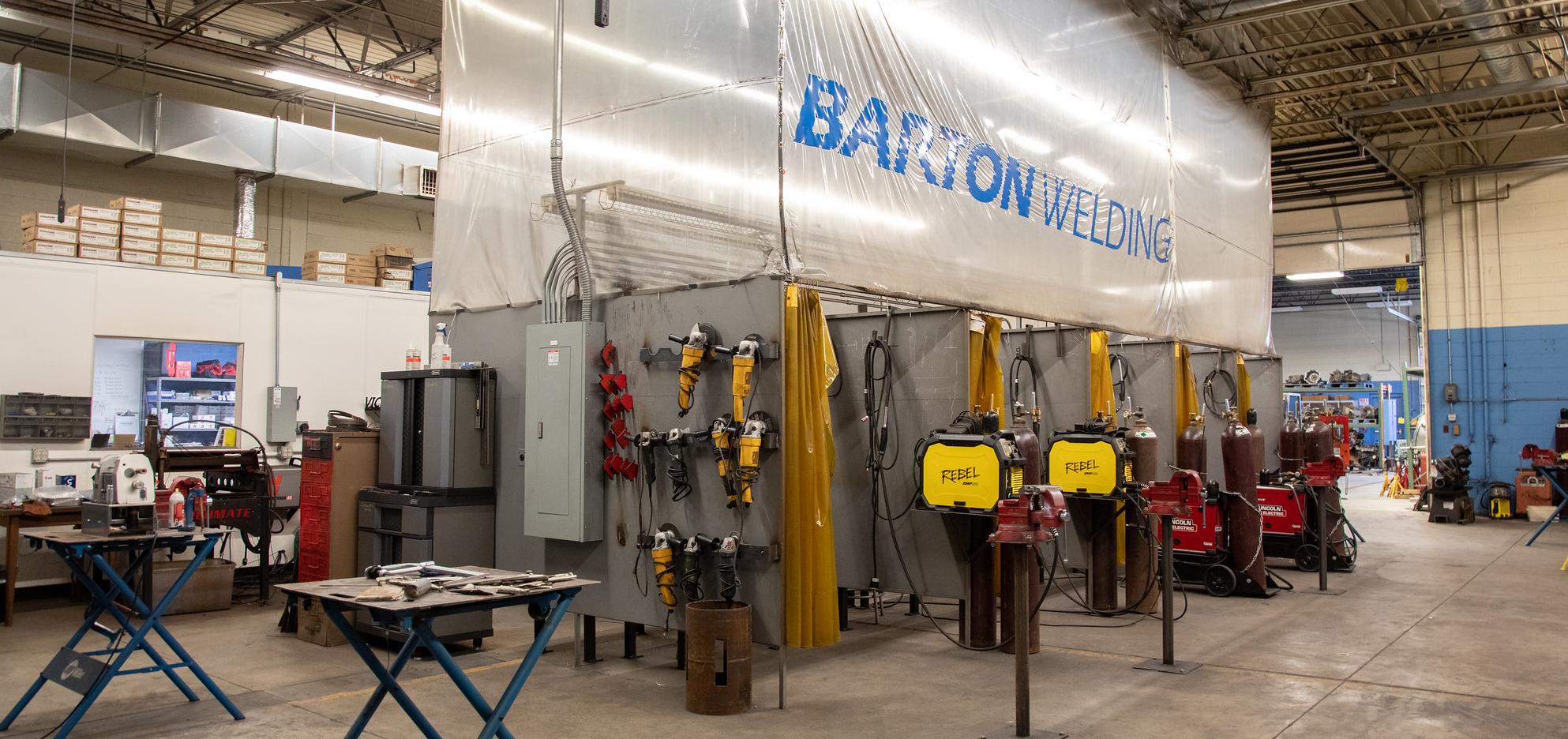
Through a variety of classroom, hands-on, and assessment activities Barton’s welding program exposes students to the different types of joints, positions, blueprint symbols, and safety standards needed to excel in a career in welding. Students have the potential to receive OSHA 10, American Welding Society Sense Level I and II industry credentials.
NEW in 2023-2024: Barton will offer two certificate levels and an Associate’s in Applied Science in Welding Technology.
All class materials, textbooks, and student gear kit are provided in the cost of tuition and fees.
Ready to get started? Request a Program Brochure!
Partnering Programs
- Excel in CTE Initiative (SB #155) for High school Juniors & Seniors
- A-OK participants
- WIA participants
- Financial Aid Eligible
- Promise Act Eligible
Associate of Applied Science
Welding (64 hours)
Certificate
Welding (17 hours - certificate guide)
Welding (38 hours - certificate guide)
View the full list of Curriculum Guides (applicable for students admitted prior to Fall 2024) and Degree Maps (applicable for students admitted Fall 2024 and after).
Check out the Course Search for a full listing of courses available.
Check out the course descriptions below to learn more about the welding program.
Gas Tungsten Arc Welding (GTAW)
Through classroom and/or lab/shop learning and assessment activities, students in this course will: explain the gas tungsten arc welding process (GTAW); demonstrate the safe and correct set up of the GTAW workstation; relate GTAW electrode and filler metal classifications with base metals and joint criteria; build proper electrode and filler metal selection and use based on metal types and thicknesses; build pads of weld beads with selected electrodes and filler material in the flat position; build pads of weld beads with selected electrodes and filler material in the horizontal position; perform basic GTAW welds on selected weld joints; and perform visual inspection of GTAW welds.
Gas Tungsten Arc Welding (GTAW) II will expand on GTAW I by including weld beads in the vertical and overhead positions, groove welds in the vertical position, fillet welds in the overhead position, and bend tests on completed groove welds.
Shielded Metal Arc Welding (SMAW)
Through classroom and/or lab/shop learning and assessment activities, students in this course will: describe the Shielded Metal Arc Welding process (SMAW); demonstrate the safe and correct set up of the SMAW workstation; associate SMAW electrode classifications with base metals and joint criteria; demonstrate proper electrode selection and use based on metal types and thicknesses; build pads of weld beads with selected electrodes in the flat position; build pads of weld beads with selected electrodes in the horizontal position; perform basic SMAW welds on selected weld joints; and perform visual inspection of welds.
Shielded Metal Arc Welding (GTAW) II will expand on SMAW I by including weld beads in the vertical and overhead positions using E-7018 and E-6010, building a pad of beads in the vertical and overhead positions using E-7018 and E-6010 electrodes, perform open root groove welds in the vertical and overhead positions using E-7018 and E-6010 electrodes, and performing advanced Shielded Metal Arc Welds (SMAW) of fillet and groove welds.
Gas Metal Arc Welding (GMAW)
Through classroom and/or shop/lab learning and assessment activities, students in this course will: explain gas metal arc welding process (GMAW); demonstrate the safe and correct set up of the GMAW workstation.; correlate GMAW electrode classifications with base metals and joint criteria; demonstrate proper electrode selection and use based on metal types and thicknesses; build pads of weld beads with selected electrodes in the flat position; build pads of weld beads with selected electrodes in the horizontal position; produce basic GMAW welds on selected weld joints; and conduct visual inspection of GMAW welds.
Gas Metal Arc Welding (GMAW) II will expand on GMAW I by including weld beads in the vertical and overhead positions, producing welds on selected weld joints, performing guided bend tests on completed groove welds.
Cutting Processes
Through classroom and/or shop/lab learning and assessment activities, students in this course will: distinguish several types of mechanical and thermal cutting equipment and processes used in the welding trade; demonstrate the safe and correct set up, operation and shut down of the Oxy-fuel (OFC) workstation; demonstrate the safe and correct set up, operation and shut down of the Plasma Arc (PAC) workstation; demonstrate the safe and correct set up, operation and shut down of the Carbon Arc Cutting with Air (CAC-A) workstations; demonstrate safe and proper operation of several types of mechanical cutting equipment; and inspect quality and tolerance of cuts according to industry standards.
Blueprint Reading
Through a variety of classroom and/or shop/lab learning and assessment activities, the students in this course will: identify basic lines, views, and abbreviations used in blueprints; interpret basic 3D sketches using orthographic projection and blueprints; solve applicable mathematical equations; use basic measuring tools; interpret scale ratios on a blueprint; identify basic welding joints and structural shapes; interpret a Bill of Materials; identify standard AWS weld symbols.
Safety (OSHA 10)
Through a variety of classroom and/or lab learning and assessment activities, students in this course will: explain job/site safety and precautions for job/site hazards; determine the uses of personal protective equipment (PPE); identify the safety equipment and procedures related to safe work practices and environment; identify fire prevention and protection techniques; explore Hazardous Communications (HazCom) including Material Safety Data Sheets (MSDS)
